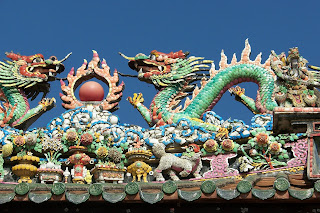It's fair to say that the China we hoped we were coming to see, the China that --in our imaginations at least -- significantly predates the modernization of the last quarter century, began for us when we left the expressway heading northeast from Shenzhen. Immediately, we found ourselves weaving along smaller roads. Our first stop was at a temple in Lufeng city in Jieshi.
The temple was actually a complex of Buddhist worship centers that covered the side of a hill, beginning at the center of the town where a gate permitted access and ending at the top of the hill. I am under the impression that many temples like this one had been shut down or, at least, that public worship had been discouraged following the Maoist revolution of 1949 and only permitted to resume during the Deng Xiaoping era, years after the Cultural Revolution.
Perhaps that view is too simplistic, as many of our views of China have been. At any rate, Yuanshan Temple is now an active worship center.
The temple grounds were filled with people, many of whom were involved in burning incense. Bundles of smoldering incense sticks were held between the palms in a prayer-like fashion while the supplicant bowed in the direction of the altar or of a particular statue. Then the sticks were stuck upright and left to smolder in sand-filled urns. Many supplicants also bought papers, single rectangular sheets or small stacks, some gold colored, which they waved in the direction of the shrines before tossing the papers into kilns to be burned. There were many of these papers lying on the ground as well.
Every so often firecrackers would pop and bang rapidly, like automatic gunfire, shattering the quiet for minutes on end, littering the ground with unburned red wrappers. Between the incense, the kilns, and the firecrackers, the smokey air was heavy with the smells of burning.

At several points food, fruit mostly, piled onto plates, was being offered as part of these worship activities. Sometimes the food was left on the ground in the main temple area; at other times, it was left on altar-tables. In several places we saw older women on their knees throwing tiles onto the ground. I was told these are called jiao, although my efforts to track down the word has led mostly to discussions of Chinese currency. The jiao looked like pieces of a broken ceramic bowl, irregular, curved, about the size of a child's palm. When these little tiles are thrown onto the ground, they land with the curved side up or down and in relation to one another. We were told these practices probably originated from local beliefs that pre-date Buddhism. The jiao are used to foretell the future.
I had been taking a lot of pictures until I spotted a sign in English that said No Pictures Inside. That bit of information made me reconsider how I took pictures outside too, especially of people going about the business of their worship activities. The fact that it was in English clearly made the prohibition hard to ignore.

Many people will describe the Buddhist rituals not as worship but as "showing respect." Given the earnest postures and attitudes of those we observed in the temples, it is hard for me to see any real line distinguishing one from the other.
We wandered ahead of the Yujia, Edward, and his parents until we found ourselves quite far up the hill at a point where people were handing money to a temple official. As we had no Chinese money at this point, we decided to turn around and find the others. We had thought to bring them up the hill to the point where we had turned back.
But we never got back up the hill. When we found them -- or they found us, Edward said,
"We've been looking for you. It is time to go!"





No comments:
Post a Comment